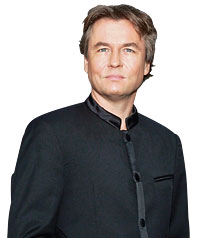
As music director of the Los Angeles Philharmonic since 1992, the Finnish conductor Esa-Pekka Salonen sits at the top of his profession. But like most showbiz Angelenos, he’s got more in mind: What he really wants to do is compose, and in 2009, he will step down from the L.A. job to give himself more time to do so. On October 5, Miller Theatre will present a Salonen retrospective as part of its “Composer Portraits” series. He spoke with Justin Davidson.
Has your balance between conducting and composing already started to change?
I’ve already cut down on conducting. I’m almost at 50-50 this year. There’s also a so-called life that has to be lived at some point, and that is what tends to eat into the composing bit, because it’s not structured by an organization, the way conducting is. So if I put aside 60 percent of the year for composing, it winds up being 50-50.
Do you need to dedicate stretches of time to writing music?
To a certain degree, I have learned to work even at night, when traveling, in airports, but it’s not ideal. And there are certain phases of the work that you cannot do like that. You can do certain technical things, but the actual putting together of ideas needs uninterrupted time. I’m also always writing down ideas or storing them in my memory, and when I have chunks of time, I start by looking at what I already have. I’m trying to avoid the blank-paper syndrome, where you sit down and your head is empty.
I hear in your music a high-octane quality that I associate with the perpetual motion of a conductor’s life. When you’re spending less time on airplanes and podiums, do you think that will have an effect on your work?
I’m too close. I suppose that the kind of music we write is a result of temperament, the people we are, the kind of life we live. There is an element of that—the constant traveling—but to a large extent, the pace of music has to do with the kind of guy I am. Slow, introspective expression is not exactly my cup of tea. Someday, I should sit down and write that kind of piece, just to see if I can.
When you are sitting by yourself for hours on end, composing, do you miss the pace of a conductor’s life?
Once I’m in composing speed, which is a lot slower than conducting, I’m happy. But the transition is very difficult. You have to wind down, and the danger is that you go to a lower energy level, which is not the right thing to do. Composing needs just as much energy, but of a different kind. So it takes me a week or two to get into the feeling, and it’s the same going the other way.
The Miller Theatre program reaches back to music from your twenties, such as Prologue and Floof. How do those early pieces sound to you now?
Floof is one of my most played pieces, so it sounds familiar, and I completely recognize most of it as me. Prologue is so old that it almost feels like a different life. It’s in pretty harsh avant-garde style, and it has all kinds of absurd comical elements as well, such as slide whistle and oboe reeds trying to imitate each other. It’s a reasonably crazy piece. Some things have stayed constant in my music: rapid shifts of mood, a tendency to combine the high and the low.
You hear and learn so much music by others—do you ever feel it’s a challenge to find your own ideas?
I don’t worry about it much. I can’t imagine any composer being hermetically sealed from other music. That would be pointless. What we do is always a commentary on what already exists. I quite often use solutions created by other people—not copying or stealing per se, but on a more abstract level. It’s not that I’m using the same notes, but I might use a harmonic structure I’ve heard before, in the same way a painter will use a familiar range of colors. I’m not worried about the 100 percent originality of an idea, because there is no such thing.
Composer Portraits
At the Miller Theatre, October 5
